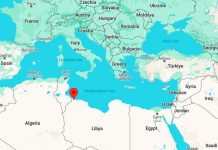
EL PASO, Texas, July 9 (UPI) — Hundreds of migrants, primarily from Central America, fleeing violence at home have encountered a new obstacle in their efforts to reach the United States to seek asylum and refuge.
For the past few weeks, immigrants lawfully seeking to reach a port of entry in order to initiate the process to seek asylum have been blocked from doing so as U.S. Customs and Border Protection officers have begun to request documents at the international boundary between the United States and Mexico at all three international bridges in El Paso and other areas along the border, rather than at the port of entry at the bottom of the bridge.
Local advocacy groups and officials say the tactic is “unprecedented.”
Ruben Garcia, executive director of Annunciation House, a non-profit organization in El Paso that provides shelter and some legal assistance to migrants, said, “We view putting the officers at the international line as a policy that, number one, needs to be made known, and number two, needs to be challenged.”
The legal process to seek asylum in the United States is for immigrants to present their case at a Port of Entry in order to initiate a process to determine if the threat is credible. The decision on whether to grant someone asylum rests solely on immigration judges.
Since the migrants are not being allowed to reach the port of entry, they’re unable to present their case to immigration officials.
CBP officials say the reason for blocking the entry of asylum seekers at the international bridges has to do with capacity.
“By putting officers on the bridge, U.S. Customs and Border Protection is taking a proactive approach to ensure that arriving travelers have valid entry documents in order to expedite the processing of lawful travel,” CBP spokesman Roger Maier said. “That being said, CBP processes undocumented persons as expeditiously as possible without negating the agency’s overall mission or compromising the safety of individuals within our custody.”
Garcia, who has worked with migrants since the 1970s, said he has challenged officials on the practice and they have told him they are not denying anyone, but rather asking them to come back at a later time. They’re not being told when they can come back and some have been blocked on multiple occasions.
CBP wouldn’t give the capacity for each of the ports of entry.
CBP officers began appearing at the halfway point of the bridges toward the end of May, just a few weeks after the Trump administration’s “zero-tolerance” policy — which aims to prosecute anyone crossing the border illegally — went into effect.
“It is a policy that is designed to keep people from presenting [their asylum case] and even more serious than that is a policy that is designed to push people to enter illegally so then they can come under the zero-tolerance umbrella,” Garcia said.
The consequences of deterring immigrants from even getting to the port of entry had a profound impact on Marvin a Honduran immigrant who fled his country along with his 17-year old son.
He is one of the initial 32 migrant parents released to Annunciation House by federal officials, and one of five who shared their stories with the media. Annunciation House provided UPI with a video of Marvin telling his story.
Marvin attempted on a couple of occasions to get to the port of entry at the end of the Santa Fe International Bridge in downtown El Paso. After his unsuccessful attempts, he felt there was only one thing he could do.
“I came through one of the POE’s and I was rejected and was forced to return. I saw no alternative but to cross illegally,” Marvin said.
He was arrested after entering the country illegally and separated from his 17-year old son, without knowing where the teen was taken.
Shortly after learning migrants were being intercepted on the bridges, Garcia and some volunteers began crossing the border to Ciudad Juarez to meet some of those blocked from entry. They began working with the Casa del Migrante shelter to ensure the migrants had all the required paperwork with them. Volunteers then escorted them across the bridge and pressured CBP officials to allow them to gain access to the Port of Entry to present their case.
Casa del Migrante usually provides shelter to people who have been deported to Mexico but also to assist asylum seekers to orient them in the process and to be prepared for whatever documentation CBP will request.
Ivonne Lopez de Lara, a social worker and coordinator of Migrants Human Rights, said the biggest concern about migrants being turned back is that it makes them vulnerable to smugglers.
In recent days, CBP has spent less time at the international boundary.
Managing the influx of Central Americans seeking asylum, along with everything else the CBP does, “requires a careful balance of our resources and space,” Maier said. “As in the past, when we’ve had to limit the number of people, we can bring in for processing at a given time. We expect that this will be a temporary situation.”






